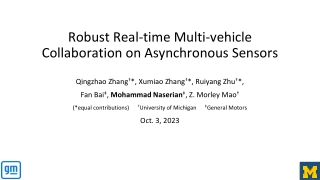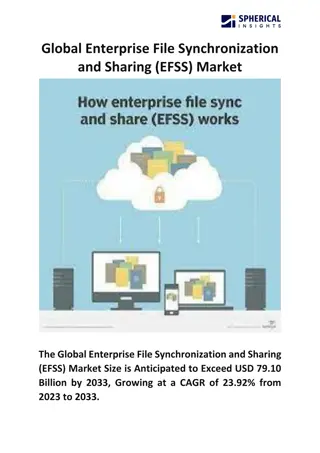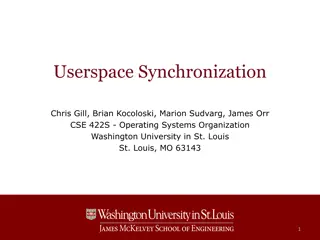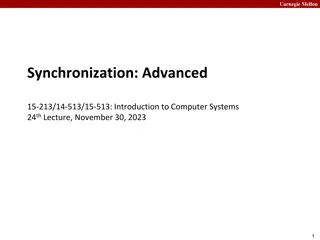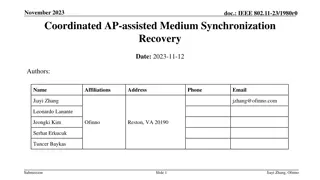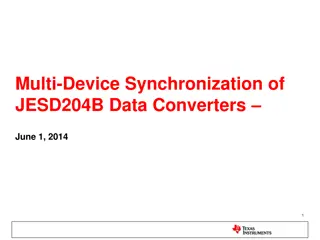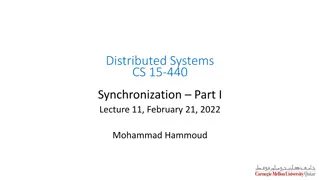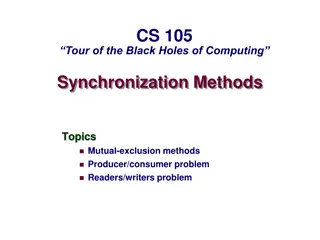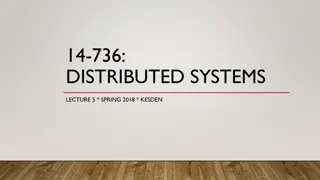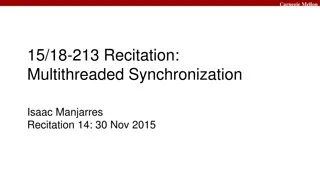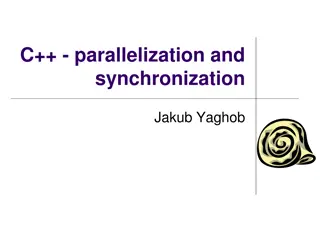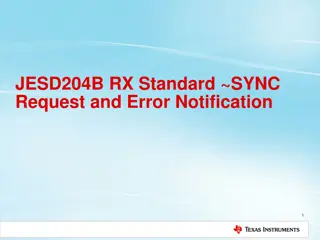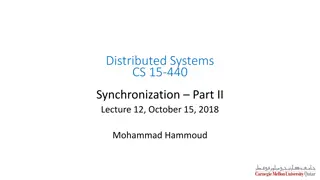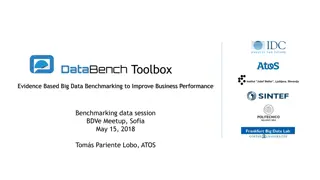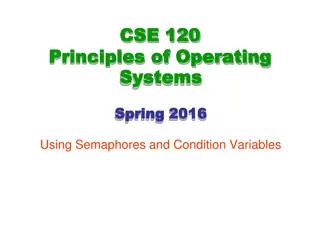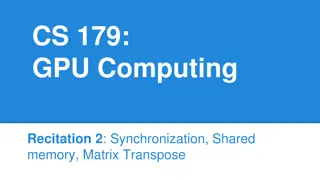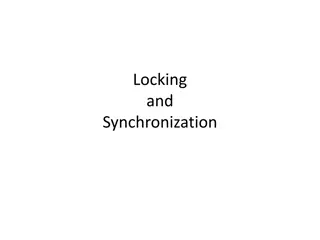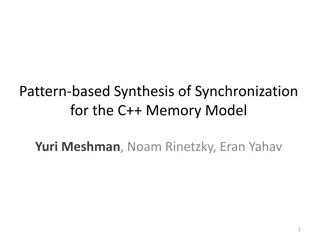Robust Real-time Multi-vehicle Collaboration on Asynchronous Sensors
A robust and real-time multi-vehicle collaboration system for asynchronous sensor data, addressing the synchronization problem and inaccurate blind spot estimation. The system leverages prediction algorithms for synchronization and enables on-demand data sharing for accurate blind spot estimation.
11 views • 12 slides
Drug Payment Methodologies
Delve into pharmacy claims payment methods, payment benchmarks, and impacts on practice. Explore various drug pricing benchmarks like WAC and AMP.
2 views • 22 slides
Mastering Synchronizing of AC Power Generating Equipment in Renewable Energy Training Course
This module focuses on educating learners about the synchronization process of AC power producing equipment, including the differences between synchronous and induction generators, calculating generator frequencies, and understanding the operation of synchroscopes and the three light bulb method for
1 views • 38 slides
OBPMark and OBPMark-ML: Computational Benchmarks for Space Applications
OBPMark and OBPMark-ML are computational benchmarks developed by ESA and BSC/UPC for on-board data processing and machine learning in space applications. These benchmarks aim to standardize performance comparison across different processing devices, identify key parameters, and provide recommendatio
10 views • 20 slides
Global Enterprise File Synchronization and Sharing
The Global Enterprise File Synchronization and Sharing (EFSS) Market Size is Anticipated to Exceed USD 79.10 Billion by 2033, Growing at a CAGR of 23.92% from 2023 to 2033.\n\n
0 views • 5 slides
Understanding Userspace Synchronization Techniques in Operating Systems
Exploring various hardware-supported atomic operations like __atomic_compare_exchange(), __atomic_add_fetch(), and __atomic_sub_fetch() for userspace synchronization. Differentiating between spinlocks and futexes, focusing on fast userspace mutexes like futexes to enhance lock performance. Detailing
0 views • 7 slides
Carnegie Mellon Synchronization and Computer Systems Lecture Updates
Carnegie Mellon's recent announcements include lab checkpoints and finals deadlines, as well as the release of an optional lab extension for the Shark File System. The lecture topics cover races, mutual exclusion, deadlock, semaphores, events, queues, reader-writer locks, starvation, and thread-safe
0 views • 43 slides
Bessemer Benchmarks for Business Growth
Leverage Bessemer Benchmarks to plot your way to the next milestone in your business. Explore average benchmarks by ARR scale, reference data for public playbook companies, and a template for benchmarking your own business metrics. Use this valuable information for pitching, board meetings, funding
4 views • 10 slides
IEEE 802.11-23/1980r1 Coordinated AP-assisted Medium Synchronization Recovery
This document from December 2023 discusses medium synchronization recovery leveraging multi-AP coordination for multi-link devices. It covers features such as Multi-link device (MLD), Multi-link operation (MLO), and Ultra High Reliability (UHR) capability defined in P802.11bn for improvements in rat
0 views • 8 slides
Coordinated AP-Assisted Medium Synchronization Recovery in IEEE 802.11-23/1980r0
This document discusses the proposal for medium synchronization recovery leveraging multi-AP coordination for multi-link devices in IEEE 802.11be EHT networks. It introduces the concept of AP-assisted medium synchronization recovery to assist non-AP STAs in transmitting frames without causing collis
0 views • 7 slides
Understanding Multi-Device Synchronization in JESD204B Data Converters
Exploring the complexities of achieving multi-device synchronization with JESD204B high-speed data converters. This presentation discusses advantages, disadvantages, and key considerations such as deterministic latency and clock design. Learn about requirements, tools, and synchronization strategies
0 views • 45 slides
Scientific Machine Learning Benchmarks: Evaluating ML Ecosystems
The Scientific Machine Learning Benchmarks aim to assess machine learning solutions for scientific challenges across various domains like particle physics, material sciences, and life sciences. The process involves comparing products based on large experimental datasets, including baselines and mach
1 views • 35 slides
Synchronization in Distributed Systems: Examples and Taxonomy
Understanding the need for synchronization in distributed systems is vital for ensuring correct operation. Examples such as vehicle tracking and file writing highlight the importance of entities coordinating and agreeing on events and resource access. A broad taxonomy of synchronization reasons is d
2 views • 31 slides
Understanding Synchronization Methods in Computing
Exploring synchronization methods like mutual exclusion, deadlock, starvation, and hardware mutex support in computing. Learn about critical sections, preventing race conditions, and the challenges of synchronization. Consider the Test and Set method, its benefits and drawbacks, and the importance o
0 views • 24 slides
Challenges of Time Synchronization in Distributed Systems
Distributed systems face challenges in synchronizing physical time due to varying network paths and clock drifts. While physical time synchronization is useful for tasks like file timestamps, it involves complexities such as estimating communication latency and improving time estimation algorithms l
0 views • 30 slides
Load Following by Nuclear Power Plants in Relation to Variable Renewable Energies' Development
The study explores the requirements of load following by nuclear power plants in the context of variable renewable energies' growth. It discusses the impact of renewable energy development on nuclear economic models and the need for dispatchable capacities. Benchmarks are set to test robustness of d
0 views • 11 slides
DL Synchronization and TCI State Activation Discussion
Discussing DL synchronization including TCI state activation with scenarios for beam indication timing, unified TCI framework, and reducing handover delay for Rel-18 LTM. Different procedures for DL synchronization and TCI state activation are explored, highlighting the importance of understanding a
0 views • 7 slides
Efficient Support for Synchronization Without Invalidations
Addressing complex software issues like data races and inefficiencies in hardware synchronization, the DeNovoSync solution provides efficient support for arbitrary synchronization without writer-initiated invalidations. By introducing disciplined shared memory with structured synchronization and exp
0 views • 40 slides
Enhancing Education with Gatsby Benchmarks
The Gatsby Benchmarks provide a structured framework for quality careers provision in education, emphasizing the importance of linking curriculum learning to careers, encounters with employers, and personal guidance. By embedding careers into the curriculum, educators can inspire and motivate studen
0 views • 10 slides
Carnegie Mellon Multithreaded Synchronization Recitation
Explore Carnegie Mellon's recitation on multithreaded synchronization, debugging tools, shared memory synchronization, critical sections, and locking. Dive into the Echo Server Sequential Handling code examples, finding weaknesses using telnet, and advanced debugging techniques with curl and binary
0 views • 34 slides
Understanding Time, Clock Synchronization, and Atomic Clocks
Delve into the intricacies of time and clock synchronization, from the rotation of the Earth to atomic clock standards. Explore the importance of physical clock synchronization and the practical implications on technologies like GPS. Uncover the terminology and methodologies involved in achieving pr
0 views • 24 slides
Understanding C++ Parallelization and Synchronization Techniques
Explore the challenges of race conditions in parallel programming, learn how to handle shared states in separate threads, and discover advanced synchronization methods in C++. Delve into features from C++11 to C++20, including atomic operations, synchronization primitives, and coordination types. Un
0 views • 48 slides
IEEE 802.11-18-1269-00-00az Clock Synchronization Investigation
In July 2018, a document was presented by Feng Jiang et al. from Intel Corporation focusing on clock synchronization between ISTA and RSTA in IEEE 802.11-18-1269-00-00az standard. The document delves into the impact of sampling clock errors on range estimation, carrier frequency synchronization in 1
0 views • 10 slides
Cut-based Analysis of Searching tH with SS Lepton Pair
Updates made in the analysis of searching for tH with SS lepton pairs include fixing bugs, updating K-factors for signals, and bypassing fake-lepton algorithms. The inclusive and exclusive selection cut-flow charts provide insights into the analysis process, with benchmarks set for synchronization s
0 views • 13 slides
Benchmarks of Fairness in Health Sector Reform: Overview and Applications
Overview of benchmarks for fairness in health sector reform, tracing historical development, adapted benchmarks, connections to social justice, structure of benchmarks, and comparison with the WHO framework. Covers key aspects such as intersectoral public health, financial barriers, equity in access
0 views • 41 slides
IAEA CIELO Evaluations for Uranium Isotopes & Criticality Benchmarks Report
This report discusses the IAEA CIELO evaluations for uranium isotopes, focusing on the impact of Standards_2016 on criticality predictions, adjustments in nuclear model calculations using the Empire code, and incorporation of experimental data to enhance performance in integral benchmarks.
0 views • 7 slides
GPU Computing and Synchronization Techniques
Synchronization in GPU computing is crucial for managing shared resources and coordinating parallel tasks efficiently. Techniques such as __syncthreads() and atomic instructions help ensure data integrity and avoid race conditions in parallel algorithms. Examples requiring synchronization include Pa
0 views • 22 slides
Performance Analysis of Synchronization Methods in Concurrent Data Structures
Explore the impact of synchronization methods on the performance and behavior of concurrent data structures in multithreaded applications. The study involves developing and implementing concurrent data structures, analyzing coarse-grain locking, fine-grain locking, lock-free mechanisms, and assessin
0 views • 25 slides
Levelling Techniques for Urban Sanitation Improvement Projects
Explore the essential aspects of levelling, including setting benchmarks, calculating important levels for a DTF, reading cross-sectional drawings, and using optical levels. Understand the significance of benchmarks, backward calculations from discharge points, and individual level definitions for e
0 views • 23 slides
Understanding JESD204B RX Standard Synchronization and Error Handling
Explore the key functionalities of the JESD204B RX Standard, including synchronization requests, error detection, and reporting mechanisms. Learn about synchronization upon initialization, error handling requiring re-initialization, and more for reliable data link setup in JESD204B interfaces.
0 views • 11 slides
Understanding Distributed System Synchronization and Logical Clocks
Continuing from the previous lecture on time synchronization, this session delved into logical clock synchronization, mutual exclusion, and election algorithms in distributed systems. Logical clocks, such as Lamport's Clock and Vector Clock, play a crucial role in defining the order of events withou
0 views • 33 slides
Enhancing Business Performance Through Big Data Benchmarking
Explore the DataBench Toolbox, a holistic benchmarking approach for big data that aims to improve business performance by identifying and integrating relevant benchmarks, filling industrial gaps, and homogenizing metrics through a user-friendly web interface. The toolbox integrates various micro-ben
0 views • 10 slides
Update on ILD Meeting in Oshu City 2014 and Future Goals
ILD meeting held in Oshu City in 2014 focused on re-inventing the ILD detector and organization to align with the physics agenda of the ILC. The event highlighted the need for optimization, cost considerations, and better connections to physics benchmarks. Goals included re-optimization efforts, re-
0 views • 17 slides
Principles of Operating Systems Synchronization Mechanisms
Operating systems utilize high-level synchronization mechanisms such as semaphores, condition variables, and monitors to provide synchronization beyond mutual exclusion. Semaphores are abstract data types that offer mutual exclusion to critical sections, while condition variables model uncounted eve
0 views • 21 slides
Synchronization and Shared Memory in GPU Computing
Synchronization and shared memory play vital roles in optimizing parallelism in GPU computing. __syncthreads() enables thread synchronization within blocks, while atomic instructions ensure serialized access to shared resources. Examples like Parallel BFS and summing numbers highlight the need for s
0 views • 21 slides
Understanding Locking and Synchronization in Multithreaded Environments
Exploring the concepts of locking and synchronization in the context of shared resources in multithreaded environments. Covering topics such as thread cooperation, coordination of access to shared variables, and the importance of synchronization mechanisms for controlling execution interleaving. Exa
0 views • 41 slides
Pattern-Based Synthesis of Synchronization for C++ Memory Model
Examining the pattern-based synthesis of synchronization for the C++ memory model, this study delves into concepts like Dekker's Algorithm and achieving mutual exclusion in parallel programming. It discusses the automatic inference of efficient and correct synchronization under the C++ memory model,
0 views • 27 slides
Synchronization and Concurrency Best Practices
This content delves into essential concepts and best practices related to synchronization and concurrency in software development. It covers topics such as locks, condition variables, semantics, and semaphores, providing insights on how to ensure thread safety, manage shared data structures, and avo
0 views • 13 slides
Iowa Program-Wide Positive Behavior Support: 3-Year Data Analysis
This report details the Iowa Program-Wide Positive Behavior Support initiative's 3-year data analysis, including cohorts, benchmarks of quality, data measures, and Teaching Pyramid Observation Tool scores. The analysis spans from 2006 to 2010 and includes information on specific cohorts, quality ben
0 views • 21 slides
Networking with VPP in OpenStack: Goals and Performance Benchmarks
OpenStack's Networking with VPP project aims to integrate a fast software dataplane, VPP, into OpenStack for enhanced communication speed in VMs and VNFs. The project focuses on scalability, simplicity, and availability through asynchronous, REST-based communications and efficient management. Perfor
0 views • 15 slides
